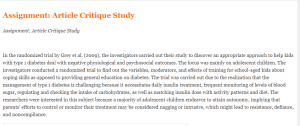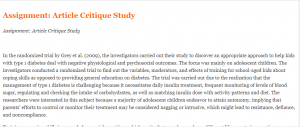Assignment: Article Critique Study
A Sample Answer For the Assignment: Assignment: Article Critique Study
Title: Assignment: Article Critique Study
Assignment Article Critique Study
In the randomized trial by Grey et al. (2009), the investigators carried out their study to discover an appropriate approach to help kids with type 1 diabetes deal with negative physiological and psychosocial outcomes. The focus was mainly on adolescent children. The investigators conducted a randomized trial to find out the variables, moderators, and effects of training for school-aged kids about coping skills as opposed to providing general education on diabetes. The trial was carried out due to the realization that the management of type 1 diabetes is challenging because it necessitates daily insulin treatment, frequent monitoring of levels of blood sugar, regulating and checking the intake of carbohydrates, as well as matching insulin dose with activity patterns and diet. The researchers were interested in this subject because a majority of adolescent children endeavor to attain autonomy, implying that parents’ efforts to control or monitor their treatment may be considered nagging or intrusive, which might lead to resistance, defiance, and noncompliance.
Training on coping skills is grounded on social cognition, which posits that people can shape different life aspects in an active manner, especially health and coping behaviors. This theory assumes that rehearsing and practicing a new behavior, for instance learning to deal efficaciously with a problematic issue, can promote positive behaviors and improve self-efficacy. Grey et al. (2009) reported the impact of training on coping skills administered for some time on children from 8 to 12 years of age. The control group received supplementary diabetes education. The researchers used an experimental design involving two groups and collected data through research assistants with special training who did not know about the assignment involving groups. Participants had to meet the age specifications and diagnosed with type 1 diabetes. They must have used insulin for at least half a year and free of other major health issues.
The sample comprised of 82 subjects, which was determined using power analysis. The intervention involved the use of Coping Skills Training, whose goal was to increase the kids’ and their parents’ extend of mastery and competence of learning nonconstructive or inappropriate coping strategies and engaging in more auspicious behavioral patterns and styles. The intervention was provided as a family-based measure to both kids and parents. This was unlike other studies where the intervention was administered to children only. The intervention coping skills that the investigators addressed were problem-solving in social settings, communication, recognizing the links between feelings, behavior, and thoughts and guided stress coping mechanisms, resolution of conflict, and self-dialogue regarding diabetes-related stressors. The investigators conducted six sessions that took place weekly in groups of between 2 and 6 kids. In these sessions, parents met separately but simultaneously. The end of each session was marked by parents and their children meeting together to discuss and share outstanding issues and discussing possible relationships between family concerns and group themes. They presented and discussed coping skills. The researchers also employed role-play to help participants practice particular coping skills in a potentially hard social setting. Children or parents received coaching from trainers to help them in giving more skillful responses.
As a control, group education was provided because of its popular use with youth with type 1 diabetes. Each of the participating children in the trial benefited from on-going diabetes education provided in quarterly clinic visits. The investigators reviewed intensive insulin regimens, sick days and sports, nutrition and carbohydrate counting, as well as updates on diabetes technology and care. The researchers provided written materials appropriate to the children’s age at every session. The finding was that both the intervention and control groups improved after a period. Researchers reported less parental control, better coping with diabetes among children, the lesser impact of diabetes and depressive symptoms, as well as better diabetes self-efficacy. These findings imply that group-based interventions might benefit kids with type 1 diabetes.
Click here to ORDER an A++ paper from our MASTERS and DOCTORATE WRITERS: Assignment: Article Critique Study
Strengths of the Study
This randomized trial has a number of strengths, and two of them are discussed here. The first strength is that the researchers apply restrictions in the population eligible for recruitment. They define the exclusion and inclusion criteria and strike a balance

between minimization of bias and generalizability. The criteria are not too narrow, implying that there are no challenges in identifying an appropriate number of participants. The researchers recruited from a large population of diabetic children from 8 to 12 years of age and the sample was supposed to be 100, out of which 82 children participated. Since the selection criteria were not too restrictive, the research can be applied to other children, which is significant in nursing practice. Similarly, the criteria were not too broad as this might have created challenges in determining the true effect of the study intervention. In this sense, selecting from children aged between 8 and 12 years implies that children aged below 8 or above 12 are not represented. The implication of this is that the outcomes of the investigation can be generalized to a specific population and not everyone (Garg, 2016). Researchers should endeavor to consider the physiologic differences associated with factors such as race and age.
In terms of data collection, it is essential that ensure that data is collected in a continuous manner rather than in binary or categorical values. The researchers were effective in continuously monitoring the intervention and control groups. The strength of the randomized trial by Grey et al. (2009) is that the researchers define the intervention and deliver it consistently. The investigators clearly define the intervention’s timing and monitor the entire research process. They define the assessment criteria and guidelines that inform decisions relating to professional judgment. They also train the study participants and their parents to ensure that they appropriately take part as expected. The researchers involve individuals with clinical expertise in type 1 diabetes management interventions, which ensures that the research is clinically safe and sound. This is because it is unethical to expose participants to an intervention without benefits or which has unnecessary risk (Newson & Lipworth, 2015). The researchers also clearly established their statistical plan and data analysis strategy before initiating the study. They minimized the likelihood of bias by applying some form of blinding. Three groups of individuals involved in research can include the blinded participants, the study team, and the researchers (Park, Usher & Foster, 2019). The most unbiased studies apply the highest level of blinding possible. In this research, only the trained assistants were blinded to the group assignment.
Weaknesses of the Study
This study used a small sample of mainly higher socioeconomic status and white families. Most of the children who participated exhibited good psychosocial adjustment and great metabolic control at baseline. Similarly, most of them were using an insulin pump. This implies that sampling was too convenient because it does not reflect what other studies relating to kids having type 1 diabetes do. Nonetheless, the researchers justify their sampling strategy that incorporated pump therapy because it is highly encouraged on the clinic recruitment site. Similarly, regarding the method, some subscales including Coping How Upsetting and DFBS Guidance and Control had low dependability and uniformity, which resulted in more measurement variance. According to Martínez-Mesa et al. (2016), the lack of representativeness in sampling is a significant cause of bias. Thus, the second weakness is that the researchers were unable to place groups with a significant number of children who enrolled to take part. This might result in a selection bias because the children scheduled for groups were generally more actuated with improved adjustment to type 1 diabetes in general.
Proposed Changes to Improve the Quality of the Study
This research could have benefitted from the inclusion of more participants in the sample. Since the 82 participants came from largely homogenous backgrounds, recruiting from other racial or social backgrounds would have improved the quality of the research. This would have minimized bias associated with the selection. It can also be seen that this research would have benefited from blinding the three research groups. In this case, the researchers might have allowed the research participants to handle some of the areas of intervention on their own and only record the results. In their research, Grey et al. (2009) should have established the link between their findings and other interventions like frequent monitoring of levels of blood sugar, regulating and checking the intake of carbohydrates. This should have been linked to the method used.
Summary of the Implications for Nursing Practice
The research by Grey et al. (2009) has important implications for nursing practice. It shows that parents and school-aged children can succeed in implementing comprehensive treatment intervention for type 1 diabetes. This is because the intervention produced remarkable metabolic control. Even though the kids showed good psychosocial adjustment in general, 11 percent reported more depressive symptoms than before. This finding is critical in clinical practice because it necessitates testing for depressive symptoms in diabetic children. This is supported by the findings of the American Diabetes Association (Scheffel, 2016). The findings of this study also show that insulin pumps provide benefits, which is an important intervention in nursing care relating to kids with type 1 diabetes.
In the sample used, the type of treatment contributed to metabolic regulation on family care or warmth, which suggests that kids using insulin pumps reflect better family-based interventions. The findings imply that it might not be necessary to remind diabetic kids to use insulin pumps. The research also accentuates the importance of group education-based and psychological interventions for kids having type 1 diabetes, as well as their parents. It is imperative to train children on coping mechanisms, but group interventions are also critical. Other elements that are worth exploring are self-efficacy and its impact on psychosocial outcomes, worry, depressive symptoms, coping, and how they relate to the quality of life in caring for diabetic children. Nevertheless, this research necessitates looking into the impact of such interventions on children from other ethnic, socioeconomic status, and racial backgrounds.
Assignment 1: Article Critique [Major Assessment 4]
Continue to work on your article critique, assigned in Week 2 and due by Day 7 of this week. This Assignment will serve as your major assessment for this course and should incorporate many of the topics covered throughout the course.
To complete:
Write a 5- to 7-page paper in APA format that includes the following:
A brief one to two paragraph overview of the study
Two to three strengths of the study and support for your selection (i.e. why is this a strength)
Two to three weaknesses of the study and support for your selection (i.e. why is this a weakness)
Note: The strengths and weaknesses you identified should be in relation to design, sampling, data collection, statistical analysis, results and discussion of the study
Proposed changes to improve the quality of the study, capitalizing on the strengths and improving on the weaknesses you identified in the study
Summary of the implications for nursing practice

